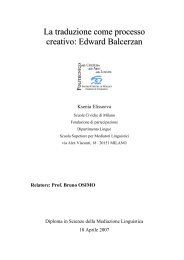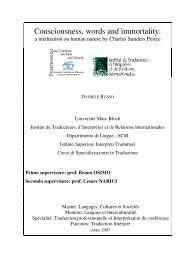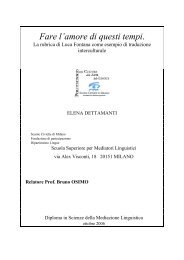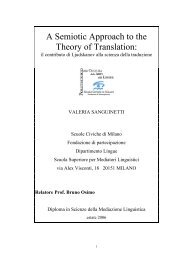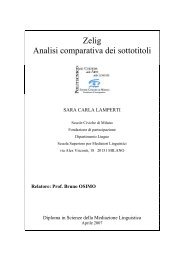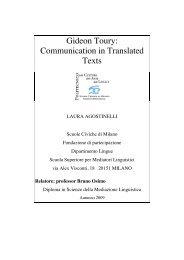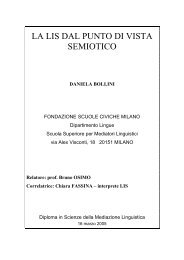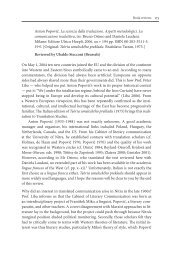Ksenia Elisseeva - Bruno Osimo, traduzioni, semiotica della ...
Ksenia Elisseeva - Bruno Osimo, traduzioni, semiotica della ...
Ksenia Elisseeva - Bruno Osimo, traduzioni, semiotica della ...
Create successful ePaper yourself
Turn your PDF publications into a flip-book with our unique Google optimized e-Paper software.
However, it is significant that a number of predicates do not specify a<br />
precise meaning even with substitution of suit and value; a long journey or<br />
financial meeting tell us nothing or almost nothing by themselves. This pertains<br />
particularly to 10♣ and 9♣, which constitute group one of predicates. “Change”<br />
is such a broad term that in fact it embraces all the other groups of predicates,<br />
any of which introduces change into the person's life. It would surely be<br />
tempting to adopt an order of reading that passes from the less informative to<br />
the more informative cards, for instance from 10♣ to A♠ or 9♦ 1 , but in our<br />
system the amount of information conveyed by a card does not influence the<br />
order of reading. Possibly, therefore, “change” should not be considered as<br />
including all the other signs of the system, but rather all the rest of the possible<br />
predicates not contained in the table of meanings. Strictly speaking, it is<br />
impossible to measure abstractly a relative amount of information or even to<br />
establish a hierarchical scale, since the informational meaning of a card can<br />
increase considerably in any specific context; and moreover, the person whose<br />
fortune is being told, whether a listener or viewer of the process of distribution<br />
and reading, could experience various subjective reactions to any card. For a<br />
certain person, a card that in context is more informative may prove to be far<br />
less quantitatively and qualitatively informative than a supposedly rather<br />
uninformative card, and vice versa. As in perceiving a work of art, subjective<br />
associations cannot be avoided, and therefore several, if not an infinitely great<br />
number, of referential variants can correspond to the sign's meaning. But also<br />
as in art, there exists none the less an objective system of rudimentary symbols<br />
that can be transcribed by “formulae” (the cards' conventional signs), by<br />
distribution in a quadrant, or more conveniently,<br />
1 For example, this is how M. I. Lekomceva and B. A. Uspenskij describe the system<br />
known to them, in «Gadanie na igral'nyh kartah kak semiotičeskaâ sistema», 86.<br />
24



